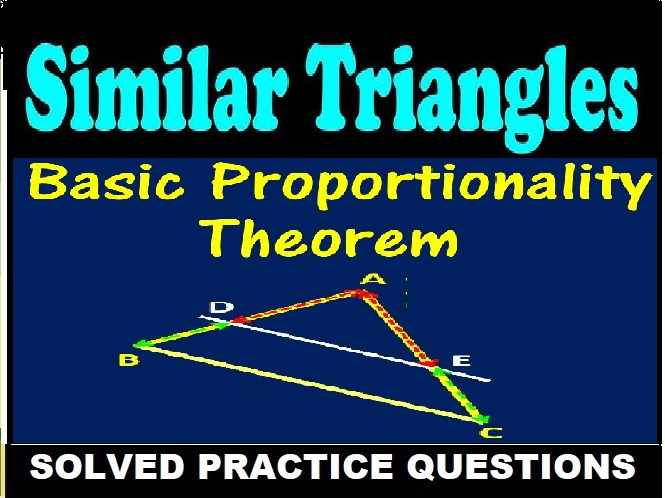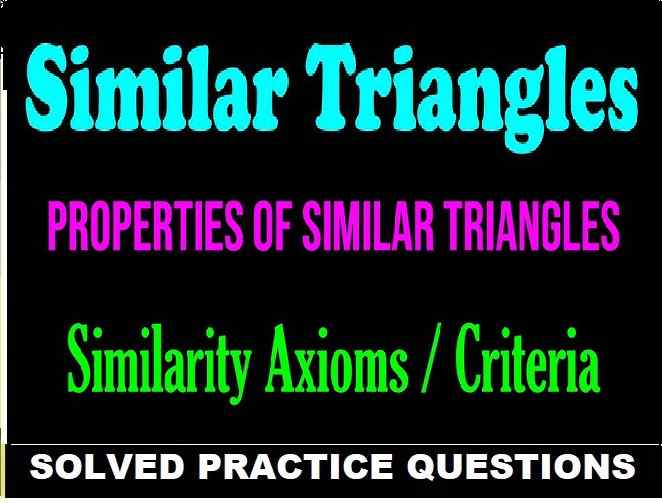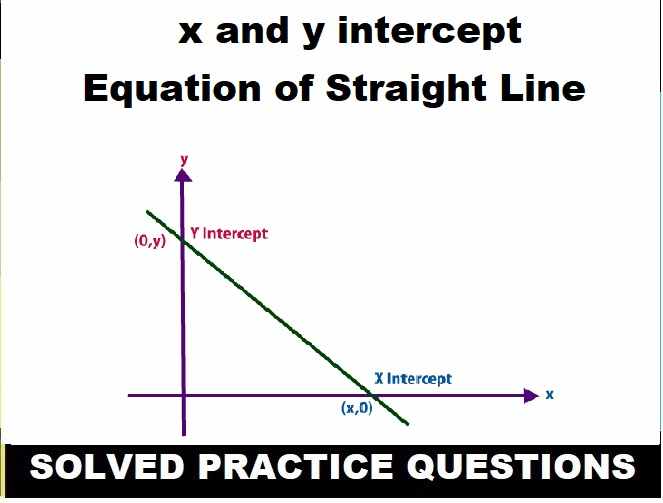Excretory System ICSE Class-10 Concise Selina Biology Solutions for ICSE Class 10 Chapter-9. We Provide Step by Step Answer of Progress Check , MCQs, Very Short Answer Type, Short Answer Type, Descriptive Answer Type Questions and Structured / Applications / Skill Type Questions of Exercise-9 Excretory System ICSE Class-10 . Visit official Website CISCE for detail information about ICSE Board Class-10.
| Board | ICSE |
| Publications | Selina Publishers PVT LTD |
| Subject | Concise Biology |
| Class | 10th |
| writer | HS Vishnoi |
| Chapter-9 | Excretory System |
| Topics | Solutions of MCQs, Very Short ,Descriptive and Structural/Skill Questions and Progress check |
| Edition | 2021-2022 |
Excretory System ICSE Class-10 Concise Selina Biology Solutions for ICSE Class 10 Chapter-9
-: Select Topic:-
E.Structured / Application / Skill Type
A. MULTIPLE CHOICE TYPE
Excretory System ICSE Class-10 Selina Biology Solutions
Page 120
Question 1
Excretion primarily involves
(a) Removal of all byproducts during catabolism
(b) Removal of byproducts during anabolism
(c) Removal of nitrogenous wastes
(d) Throwing out excess of water
Answer 1
(c) Removal of nitrogenous wastes
Question 2
Maximum amount of water from the glomerular filtrate is reabsorbed in
(a) Proximal convoluted tubule
(b) Descending limb of loop of Henle
(c) Ascending limb of loop of Henle
(d) Distal convoluted tubule
Answer 2
(a) Proximal convoluted tubule
Question 3
Which one of the following in real sense is not an excretory activity?
(a) Giving out carbon dioxide
(b) Passing out faecal matter
(c) Sweating
(d) Removal of urea
Answer 3
(c) Sweating
Question 4
In humans, urea is formed in
(a) Ureter
(b) Liver
(c) Spleen
(d) kidney
Answer 4
Liver
B. VERY SHORT ANSWER TYPE
Concise Biology Solution Chapter- 9 Excretory System ICSE Class-10
Page 120-121
Question 1
Name the following:
(a) The outer region of kidney containing the Bowman’s capsule.
(b) The tuft of capillaries inside the Bowman’s capsule.
(c) The part of kidney tubules where the term urine is first used for the fluid in it.
(d) The organ which filters urea.
(e) The organ through which urea is released outside the body of a human being.
(f) The specific pigment found in urine.
Answer 1
(a) Cortex
b) Glomerulus
(c) Collecting duct
(d) kidneys
(e) Ureter
(f) Urobilin or urochrome
Question 2
Given below are two sets (a and b) of five terms each. Rewrite the terms in their correct order so as to be in logical sequence.
(a) Afferent arteriole, renal vein, capillary network, glomerulus, efferent arteriole
(b) Renal artery, urethra, ureter, kidney, urinary bladder
Answer 2
(a) Afferent arteriole, glomerulus, efferent arteriole, capillary network, renal vein
(b) Renal artery, kidney, ureter, urinary bladder, urethra
Question 3
In each of the following sets of body parts/substances/processes, pick out the one item which overall includes the remaining four
(a) Glomerular filtrate, Bowman’s capsule, ultrafiltration, glomerulus, blood plasma.
(b) Skin, liver, lungs, kidneys, excretion.
(c) ADH, water, pituitary, osmoregulation, urine.
(d) CO2, bile pigments, water, excretion, urea.
Answer 3
(a) Ultrafiltration
(b) Excretion
(c) Osmoregulation
(d) Excretion
Question 4
Name the disease caused due to the following abnormal constituents in urine :
(a) Blood ……………..
(b) Glucose ……………..
(c) Albumin ……………..
(d) Bile pigments ………………
Answer :
(a) haematuria
(b) glycosuria
(c) albuminuria
(d) anaemia, hepatitis
C. SHORT ANSWER TYPE
Revised Concise Biology Solution Chapter- 9 Excretory System
Page 121
Question 1
Write down the functional activity of the following parts:
(a) Glomerulus
(b) Collecting duct
(c) Ureter
(d) Vasa recta
(e) Urethra
Answer 1
(a) Glomerulus is involved in the process of ultrafiltration. The liquid part of the blood which is plasma including urea, salts, glucose filters out from the glomerulus into the renal tubule.
(b)
(c) Ureter carries urine to the urinary bladder by ureteral peristalsis.
(d)
(e) Urethra is involved in the process of micturition i.e. expelling urine out of the body.
Question 2
Match the items in Column I with those in Column II and write down the matching pairs.
| Column I | Column II |
| (a) Bowman’s Capsule | (i) Renal artery |
| (b) Contains more CO2 and less urea | (ii) Regulates amount of water excreted |
| (c) Anti-diuretic hormone | (iii) Renal vein |
| (d) Contains more urea | (iv) Glomerulus |
Answer 2
| Column I | Column II |
| (a) Bowman’s Capsule | Glomerulus |
| (b) Contains more CO2 and less urea | Renal Vein |
| (c) Anti-diuretic hormone | Regulates amount of water excreted |
| (d) Contains more urea | Renal artery |
Question 3
Fill in the blanks in the following passage to make it a meaningful description.
In a nephron, the _______ flows through the ________ under great pressure. The reason for this great pressure is that the ________ (outgoing) _________ is narrower than the __________ (incoming). This high pressure causes the _______ part of the blood to filter out from the ________ into the _______ capsule.
Answer 3
In a nephron , the blood flows through the glomerulus under great pressure. The reason for this great pressure is that the efferent (outgoing) arteriole is narrower than the afferent arteriole (incoming). This high pressure causes the liquid part of the blood to filter out from the glomerulus into the renal capsule.
Question 4
Name the following:
(a) Three nitrogenous wastes of our body.
(b) Three organic wastes of our body.
(c) Three inorganic wastes of our body.
(d) Three main parts of our urinary system.
(e) Six main parts of nephron.
(f) Three stages of urine formation.
(g) Three types of fluids in different parts of a nephron.
Answer 4
(a) Ammonia , Urea , Uric acid
(b) Creatine , Creatinine , Amino acids
(c) Ammonia , Urea , Uric acid
(d) kidney , ureters , urinary bladder
(e) Bowman’s capsule, proximal tubule, Loop of Henle, distal tubule and the collecting duct.
(f) glomerular filtration, reabsorption, and secretion.
(g) Juxtamedullary nephrons start low in the cortex near themedulla and have a long loop of Henle, which penetrates deeply into the renal medulla: only they have their loop of Henle surrounded by the vasa recta. The other two are water and urine glomerular filtrate.
Question 5
Choose the odd one out in each of the following sets and write the category for the remaining terms:
(a) Kidney, ureter, neuron, urethra, urinary bladder
(b) Ammonia, urea, excess sodium chloride. uric acid
(c) Cortex, medulla, loop of Henle, hilum
(d) Glomerulus, collecting duct, papilla, Bowman’s capsule
Answer 5
(a) neuron
(b) excess sodium chloride
(c) hilum
(d) papilla
Question 6
Write full forms of the following abbreviations
(a) PCT : ……
(b) DCT : ………….
(c) ADH : ………..
(d) ORS : ………..
Answer 6
(a) PCT – Proximal convoluted tubule.
(b) DCT – Distal convoluted tubule.
(c) ADH – Antidiuretic hormone.
(d) ORS – Oral rehydration solutions.
Question 7
Write the exact location of each of the following:
(a) Kidney
(b) Uriniferous tubule
(c) Malpighian capsule
(d) Loop of Henle
Answer 7
(a) Dorsal side of the body above pelvic region
(b) Nephron is called uriniferous tubule which is both in cortex and Medulla
(c) Inside kidney at cortex region
(d) Loop of Henle in medulla region mainly found in Juxtaglomerular nephron with is only 5%
D. DESCRIPTIVE ANSWER TYPE
Revised Concise (Selina Publication ) Biology Solution Chapter- 9, Excretory System ICSE Class-10
Page 121
Question 1
Define the following terms:
(a) Excretion
(b) Kidney
(c) Micturition
(d) Osmoregulation
Answer 1
(a) Excretion : Metabolic waste products (such as urea and carbon dioxide) that are eliminated from the body.
(b) Kidney : One of a pair of organs in the abdomen. The kidneys remove waste and extra water from the blood (as urine) and help keep chemicals (such as sodium, potassium, and calcium) balanced in the body.
(c) Micturition – The process of expelling urine out of the body through urethra by opening the sphincter muscles passing of urine involving relaxation of sphincter muscles between the urinary bladder and urethra.
(d) Osmoregulation – It is a process of maintaining the blood composition of the body i.e. the normal osmotic concentration of water and salts in the body.
Question 2
Differentiate between the following pairs of terms:
(a) Bowman’s capsule and malpighian capsule
(b) Diuresis and Uremia
(c) Renal cortex and renal medulla
(d) Renal pelvis and renal papilla
(e) Urea and urine
(f) Excretion and secretion
Answer 2
(a) Bowman’s capsule is a thin walled cup containing the glomerulus. This Bowman’s capsule along with the glomerulus is known as malpighian capsule.
(b) Uremia is a clinical syndrome marked by elevated concentrations of urea in the blood and associated with fluid, electrolyte, and hormone imbalances and metabolic abnormalities, which develop in parallel with deterioration of renal function.
Diuresis is a condition in which the kidneys filter too much bodily fluid
(c) The renal cortex is the outer darker region of the kidney whereas the renal medulla is the inner lighter region of the kidney.
(d) Renal pelvis is the expanded front end of the ureter in the kidney whereas the renal papilla is the apex of the renal pyramid which projects into the pelvis.
(e) Urea is the chief excretory product which is excreted in the form of urine whereas urine is the filtrate left after reabsorption and tubular secretion which contains 95% water and 5% solid wastes.
(f) Excretion is the process of removal of chemical wastes especially nitrogenous wastes from the body.
Secretion is giving out by a cell or a gland some substance that has some utility for the body.
Question 3
Give reason/explain :
(a) Excretion is a necessary process of our body.
(b) If we donate one kidney to a needy patient it would
not cause any harm to us.
(c) We urinate fewer times in summer than in winter
and the urine passed is generally thicker.
Answer 3
(a) The process of removing waste products produced in the cells of living organisms is called excretion. … Hence it is necessary to remove such poisonous waste materials from our body
(b) Donating one kidney does not cause any harm as a single kidney can perform all the necessary vital functions
(c) In summer we lose considerate part of water through perspiration. Hence, kidneys have to reabsorb more water from the urine which makes the urine thicker and concentrated. While in winter very less amount of water is lost through perspiration. Therefore, we urinate fewer times in summer than in winters.
Question 4
What is a uriniferous tubule ? How does it function ?
Answer 4
The structural and functional unit of the kidney is the uriniferous tubule, commonly known as the kidney tubule. It receives impure blood from the renal artery and excretes wastes as urine.
Question 5
Why is it necessary to maintain a normal osmotic concentration of the blood?
Answer 5
Maintaining a normal osmotic concentration in the body means regulating the percentage of water and salts. If this regulation mechanism fails we either end up losing vital salts and water or may accumulate unwanted salts and excess water in our body.
Question 6
Explain the terms ultrafiltration and selective absorption.
Answer 6
Ultrafiltration – Ultrafiltration involves filtration of the blood which takes place in the glomerulus. The blood containing urea from the afferent arteriole enters the glomerulus under high pressure. The high pressure is created because the efferent arteriole is narrower than the afferent arteriole. The high pressure causes the liquid part of the blood to filter out from the glomerulus into the renal tubule. This filtrate is known as ‘glomerular filtrate’.
Glomerular filtrate consists of water, urea, salts, glucose and other plasma solutes. Blood corpuscles, proteins and other large molecules remain behind in the glomerulus. Therefore the blood which is carried away by the efferent arteriole is relatively thick.
Selective absorption The Glomerular filtrate entering the renal tubule contains a lot of usable materials such as glucose and sodium. As this filtrate passes down the renal tubule, a lot of water along with these usable materials is reabsorbed. Such reabsorption is called ‘selective absorption’. The reabsorption occurs only to the extent that the normal concentration of the blood is undisturbed.
Question 7
What is dialysis? Under what conditions is it carried out?
Answer 7
Dialysis involves the use of artificial kidney or a dialysis machine. The patient’s blood is from the radial artery is led through the machine where excess salts and urea is removed. The purified blood is then returned to a vein in the same arm.
Dialysis is carried out in case of failure of both the kidneys. In case there is a permanent damage, then the dialysis is to be repeated for about 12 hours twice a week.
E. STRUCTURED/APPLICATION/SKILL TYPE
Concise Biology Solution Chapter- 9 Excretory System ICSE Class-10
Page 121-122
Question 1
Look at the figure given below. It is a section of human kidney as seen from the front.
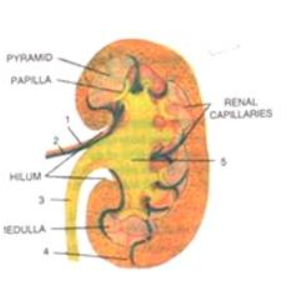
(a) Is it a longitudinal section or a cross-section?
(b) Name the parts numbered 1-5.
(c) Which area/part (give its name and number given on the diagram) which contains the following:
(i) Malpighian capsule
(ii) The blood vessel with least/no nitrogenous waste.
(iii) Freshly collected urine
Answer 1
(a) It is a longitudinal section of the kidney.
(b) 1-renal artery, 2-renal vein, 3-ureter, 4-cortex, 5-pelvis
(c)
(i) 4/cortex
(ii) medulla
(iii)5/pelvis
Question 2
Given below is the figure of certain organs and associated parts in the human body. Study the same and answer the questions that follow:
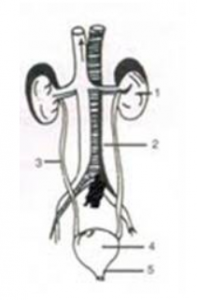
(a) Name all the organ-systems shown completely or even partially.
(b) Name the parts numbered 1 to 5.
(c) Name the structural and functional unit of the part marked ‘1’.
(d) Name the two main organic constituents of the fluid that flows down the part labeled ‘3’.
(e) Name the two major steps involved in the formation of the fluid that passes down the part labeled ‘3’.
Answer 2
(a) Excretory system and Circulatory system.
(b) 1-kidney, 2-renal artery, 3-ureter, 4-urinary bladder, 5-urethera
(c) Nephron
(d) Urea and ammonia
(e) Ultrafiltration and selective reabsorption
Question 3
The following diagram represents a mammalian kidney tubule (nephron) and its blood supply.
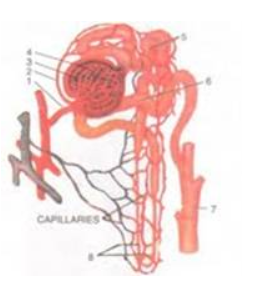
Parts indicated by the guidelines 1 to 8 are as follows:
- Afferent arteriole from renal artery
- Efferent arteriole
- Bowman’s capsule
- Glomerulus
- Proximal convoluted tubule with blood capillaries
- Distal convoluted tubule with blood capillaries
- Collecting tubule
- U-shaped loop of Henle
Study the diagram and answer the questions that follow:
(a) Where does ultrafiltration take place?
(b) Which structure contains the lowest concentration of urea?
(c) Which structure contains the highest concentration of urea?
(d) Which structure (normally) contains the lowest concentration of glucose?
(e) Where is most water reabsorbed?
(f) State the reason for the high hydrostatic pressure in the glomerulus
(g) Name the part of nephron which lie in the renal medulla
Answer 3
(a) 4/Glomerulus
(b) 2/Efferent arteriole
(c) 1/ Afferent arteriole from renal artery
(d) 7/Collecting tubule
(e) 5/ Proximal convoluted tubule with blood capillaries
(f) The reason for this greater pressure is that the efferent arteriole is narrower than afferent arteriole. This high pressure causes the liquid part of the blood to filter out from the glomerulus into the renal tubule.
(g) Exon
Question 4
Given below is a highly simplified diagram of the human kidney cut open longitudinally. Answer the questions that follow:

(a) Define excretion.
(b) Why does the cortex of the kidney show a dotted appearance?
(c) Why does the medulla of the kidney show a striped appearance ?
(e) Write two differences in composition of the blood flowing through the blood vessels, ‘A’ and ‘B’.
Answer 4
(a) The process of removal of chemical wastes especially nitrogenous waste from the body is known as excretion.
(b) As the cortex region contains numerous nephrons or kidney tubules, therefore, it shows a dotted appearance.
(c) Due to neuron ending
(d) The blood vessel ‘B’ is renal artery and the blood vessel ‘A’ is renal vein.
So the blood vessel ‘B’ contains oxygenated blood with high concentration of urea and glucose whereas the blood vessel ‘A’ contains deoxygenated blood with low concentration of urea and glucose as compared to renal artery.
Question 5
Study the diagram given below and then answer the questions that follow:
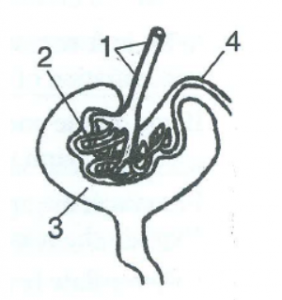
(a) Name the region in the kidney where the above structure is present?
(b) Name the parts labelled 1, 2, 3, and 4.
(c) Name the stages involved in the formation of urine.
(d) What is the technical term given to the process occurring in 2 and 3? Briefly describe the process.
Answer 5
(a) The structure is a Bowman’s capsule, which is part of the nephron. The Bowman’s capsule is found in the cortex of the kidney.
(b)
1 – Afferent arteriole
2 – Glomerulus
3 – Bowman’s capsule
4 – Efferent arteriole
(c)
Urine formation occurs in two steps – ultrafiltration and reabsorption.
(d)
The process occurring in 2 and 3 is known as ultrafiltration. In the glomerulus, the blood flows under high pressure because of the narrow lumen of the capillary network of the glomerulus. This forces most of the components (both waste and useable materials) of the blood out of the capillaries. This process of the filtration of blood under high pressure in the Bowman’s capsule is known as ultrafiltration.
Return to Concise Selina ICSE Biology Class-10
Thanks
